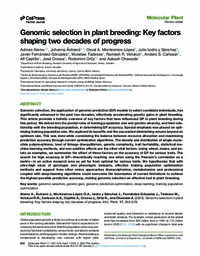Genomic selection in plant breeding: Key factors shaping two decades of progress

Authors:
Genomic selection, the application of genomic prediction (GP) models to select candidate individuals, has significantly advanced in the past two decades, effectively accelerating genetic gains in plant breeding. This article provides a holistic overview of key factors that have influenced GP in plant breeding during this period. We delved into the pivotal roles of training population size and genetic diversity, and their relationship with the breeding population, in determining GP accuracy. Special emphasis was placed on optimizing training population size. We explored its benefits and the associated diminishing returns beyond an optimum size. This was done while considering the balance between resource allocation and maximizing prediction accuracy through current optimization algorithms. The density and distribution of single-nucleotide polymorphisms, level of linkage disequilibrium, genetic complexity, trait heritability, statistical machine-learning methods, and non-additive effects are the other vital factors. Using wheat, maize, and potato as examples, we summarize the effect of these factors on the accuracy of GP for various traits. The search for high accuracy in GP—theoretically reaching one when using the Pearson’s correlation as a metric—is an active research area as yet far from optimal for various traits. We hypothesize that with ultra-high sizes of genotypic and phenotypic datasets, effective training population optimization methods and support from other omics approaches (transcriptomics, metabolomics and proteomics) coupled with deep-learning algorithms could overcome the boundaries of current limitations to achieve the highest possible prediction accuracy, making genomic selection an effective tool in plant breeding.
